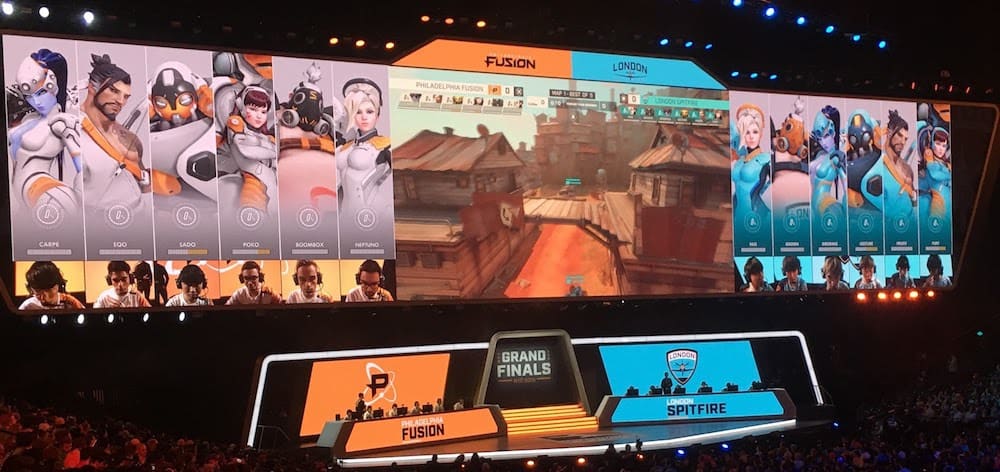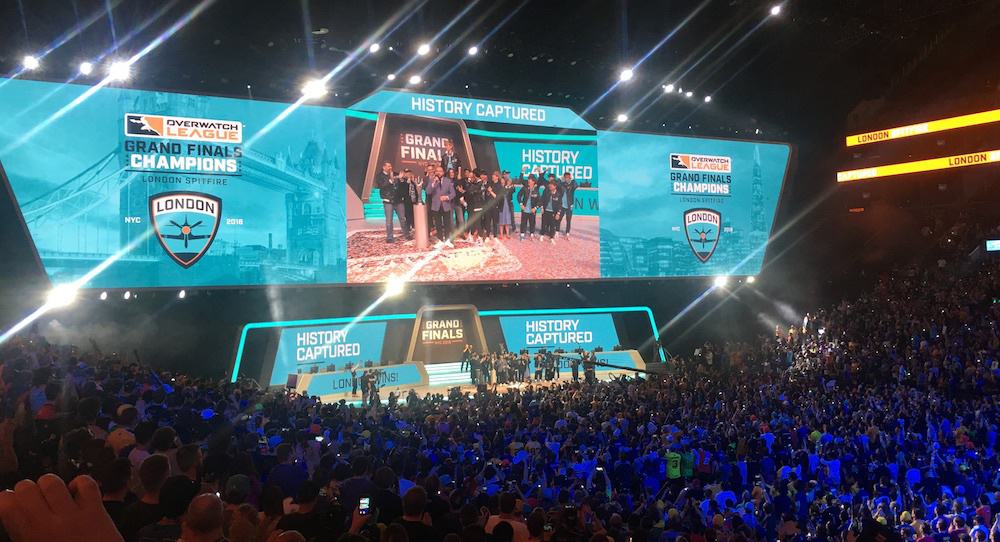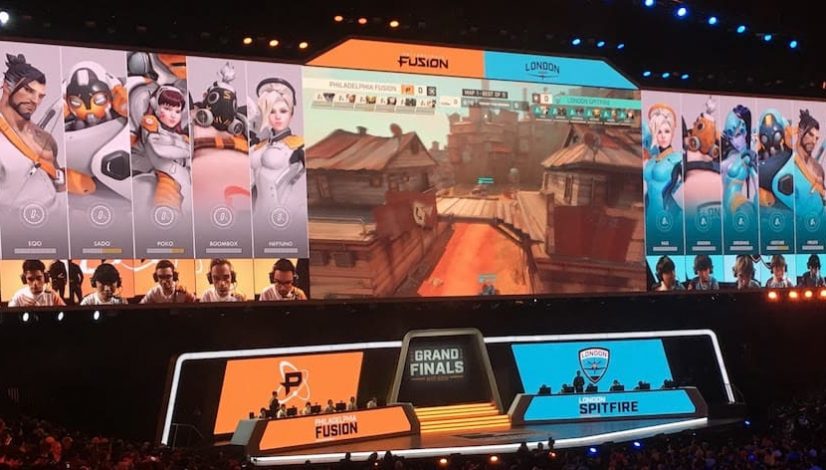The Overwatch League is Real, and It’s Fantastic
I approached Barclay’s Center to take in Saturday’s Overwatch League Grand Final match alongside a group of prototypical eSports fans: nerds in their late teens. One girl in this group was relaying to her friends the rumor that a new player-character would be announced at this, the conclusion of Overwatch League’s (OWL) wildly successful first season.
That’s when a 40-something mom turned around and confidently corrected the young woman: they wouldn’t be introducing a new character, but new “skins” for existing ones. My surprise doubled when one of the young men responded “Maybe they’ll have DJ Khaled make the announcement—We got a new skin! And another one! Another one! Another one!” That’s how I discovered that DJ Khaled was the warm-up act for that afternoon’s live video games, and that I officially I had no idea what I was in for.

The jumbotron showed live gameplay as well as all 12 players’ avatars; Sam Roos/ High Times
A quick primer for readers unfamiliar with Overwatch: the game is a first-person shooter (FPS) featuring two teams of six competing head-to-head. Each player chooses one of 28 characters, each with unique strengths and weaknesses, to compete in various types of games, including king-of-the-hill and capture the flag type contests. The style of the game is bright and cartoonish, a family-friendly anime aesthetic, but the strategy is intricate and the pace of play blistering. The game is as much a contest of quick-twitch muscles and hand-eye coordination as it is teamwork and game theory.
When I offered to cover this event for High Times, I thought there might be a story in the role marijuana has amongst Overwatch fans. Personally, I associate video games with getting baked on a couch for a couple hours of Mario Kart with friends. Obviously, the professional players aren’t high, but what about the fans? Did they play like stoners, or like professionals? This was my planned angle of inquiry.

Cosplayers grouped up for pre-match pictures; Sam Roos/ High Times
But that line of questioning was quickly proven reductive. Overwatch fans are much too diverse to be generalized. All races seemed well represented amongst the crowd of over 11,000 people. Roughly half the attendees were female. Of course, there were some young nerds in thick glasses and anime t-shirts, but I passed a couple in their 50’s rocking Shanghai Dragons jerseys and spotted a yuppie couple still wearing their VIP lanyards at a nearby boutique grocery store later that day. The crowd-watching cameras kept finding a black woman in an incredible gender-bending cosplay of the character Lucio, and a white man doing the same in an elaborate Zarya costume. There were children of all ages, bros pounding craft beers, and High Times journalists sneaking hits off their vape. Truly, the OWL welcomes all kinds.
Before heading to my seat, I toured the venue. I chatted with a group of men and women in their 20s while we waited to take photos of the cosplayers (there were about two dozen “serious” cosplayers in all at Barclay’s, all but one or two of them paying customers). These fans were disappointed that the local team, NYXL, had fallen short of the finals, but they were still thrilled to be there. All of them kept coming back to the same thought: they couldn’t believe the scale of this event.
That sense of disbelief remained the throughline as I chatted with other fans. People were waving signs (there was a sign-making station in the concourse), everyone was outfitted with flashing LED wristbands, and DJ Khaled did indeed perform a very strange 15-minute hype set. Everyone—my neighbors, the announcers, me—kept coming back to the same word: “insane.”
My seat was next to a group of Philadelphia Fusion fans who had driven up from Philly to watch their eSports team take on the London Spitfire team in the finals. They were far from the only ones to travel. I met a family that had driven down from Nova Scotia, and fans from Pittsburgh and Colorado were interviewed pregame on the enormous LED screen. They also interviewed the London Spitfire GM Susie “lilsusie” Kim, who, in any other sport, would be making national headlines as a woman of color running a men’s team, and Philadelphia coach Yann “Kirby” Luu, who wore a coat and tie that evoked a 1950s football coach. The players themselves were perhaps the least diverse group in the building: all of London’s players are South Korean men, as are half of Philadelphia’s six-person starting lineup (although Philly’s extended roster also has players from England, Israel, Finland, Canada, Spain, France, Russia and Sweden). The lack of female players (the league has none) is perhaps the only part of the OWL that could aspire to diversify further.
Once the match finally began, any lingering thoughts that this crowd was any less passionate or knowledgeable than an average professional sports crowd went out the window. It was among the loudest sporting events I’ve ever attended (rivaled only by my visits to the Golden State Warriors’ Oracle Arena and the Seattle Seahawks Centurylink Field, notoriously two of the loudest buildings in sports). Fans screamed for some players and booed others, gasped as they saw plays developing the way you often hear in soccer matches, and rose to their feet routinely to celebrate superior play. Watching the gameplay via the massive Jumbotron was actually fine; unlike in basketball or hockey, where the action is often far from your seat or at a bad angle for your view, everyone in the building saw exactly the same thing.

The champions London Spitfire accepting their trophy; Sam Roos/ High Times
The only failing of the event was that it was over too quickly. London had won the first match in a best-of-three series the night before, and on Saturday they made short work of Philadelphia, winning the first and only match of the day 3-0. As London crept closer to their victory, you could feel the building rooting for Philly to rally, to give us a show. And while the Fusion fell short, they did make an improbable overtime comeback on the third map that had all 11,000 of us on our feet screaming. That moment proved to me that this league, and eSports in general, have a legitimate future in the professional sports landscape. Say what you will about video games’ worthiness of the term “sport”— from my seat, the experience was indistinguishable from a live NBA, NHL, NFL or MLB experience. We did the wave. They had five-dollar hot dogs. Celebrities were featured on the crowd-cam. It was sports.
Ultimately, I learned very little about marijuana in the Overwatch community. The Philly fans next to me like to sometimes get stoned and watch, but when they play, they stay sober. The six-man team on the other side of me identified with the way I often combine video games and pot, but had a strict rule that they only got baked before casual gaming, never before ranked play as a team. I’m sure a proper survey of the crowd would have turned back wildly different answers on all areas of that spectrum because this isn’t a niche interest anymore. This is mainstream entertainment, and we’re only going to see more of it.
The post The Overwatch League is Real, and It’s Fantastic appeared first on High Times.


